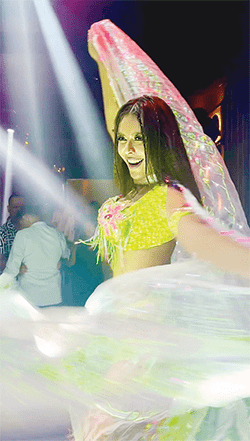12/09/2023
12/09/2023
A WEAVER OF PASSIONS IN EVERY MESMERISING STEP

Samira Boudargham who was born in Esquel Chubut Argentina, and lived in this beautiful city until she was 17 with her mother Yanina, and sister Nayla and brother Farid says she studied in Buenos Aires, Argentina where she lived for about 7 years, where she was fortunate to study dance, psychology and worked as a dance teacher and belly dancer.
In an exclusive interview, she told the Arab Times, her dream was to travel to Lebanon to see her family town and Egypt to study dance with Egyptian teachers and pay a visit to all the tourist attractions. “When I arrived in Egypt to supposedly spend two weeks,” she says, “thanks to a friend who put me in contact with the Nile Maxim Boat located in Cairo, where working for two weeks I signed a work contract that we have renewed and I have now been here for 4 years.”
“I am very happy with my profession and I am very grateful to this beautiful country Egypt that has opened its doors to me and gives me so much love every day,” she says. With rhythms and graceful movements, Samira has captivated or rather mastered the enchanting art of Belly Dance. With a deep passion for cultural expression and an undeniable talent, Samira seamlessly weaves together tradition and innovation, mesmerizing audiences with every movement and every intricate step she takes.

Arab Times: How did you first become interested in belly dancing, and what inspired you to pursue it as a career?
Samira: I started dancing in a small city in southern Argentina called Esquel. My mother worked in a Lebanese association and my family also has Lebanese ancestry, so we were all very related to this association. When I was only 4 years old, my mother took me to classes and I spent my entire childhood and adolescence there. When I was 17 years old I went on vacation to Buenos Aires, where there the Arabian Dance
School (ADS), the biggest in town. After my audition, I got admission directly to fourth year. Filled with enthusiasm, I was going to live alone in Buenos Aires with the help of my grandparents and my mother.
AT: Could you share a bit about your training and background in belly dancing? How did you develop your skills?
Samira: Until I was 17, dance had been the protagonist in my life, but when I moved to another city to continue studying dance at the ADS of my teacher Amir Thaleb, dance was the beginning of the project of my life. I graduated as a performer and teacher. I was part of the ballet company of this school. I also created my own school where I taught young girls and women. We had our own yearend show and events. I traveled within my country teaching dance and being part of different events; that greatly enriched my dance.
AT: What aspects of belly dancing do you find most captivating or fulfilling? Is there a specific style or element that resonates with you the most?
Samira: I love the connection that is generated between the belly dance technique and Arabic musical pieces, Arabic instruments, and their nuances. I feel it sublime, especially the interpretation of Tarab music and classical music. They are my favorites to interpret. Connecting with the voice of the great singers of this genre is something that I couldn’t explain in words, that’s why I dance to it. AT: Belly dancing encompasses various styles and traditions. Can you tell us about the styles you specialize in and how they differ from one another? Samira: Throughout my life, I studied dance and I think it is infinite, the Arab world is very large, each country has its folklores and I had the opportunity to study many of them. But I specialized in belly dance, I could say that the Egyptian style, so earthly and passionate, is the one I always connect with but I love seeing the Lebanese style, with its unique dynamics.
AT: How do you approach choreography and performance creation? What goes into crafting a captivating belly dance routine?
Samira: Today, in general I do not have complete choreographies, but rather planned choreographies, in certain musical moments I know what I am going to do but I like to dance and do what I feel at the moment. My performance is not always the same. I change according to the event, weddings, restaurant shows, henna parties, clubs and more. But they are all characterized by having a dynamic energy since during my performance there are songs about love, heartbreak, traditional songs and new ones.
AT: Belly dancing is often seen as an expressive art form. How do you convey emotions and tell stories through your performances?
Samira: The wonderful thing about belly dancing is that feeling that is created between the piece of music and the dancer. I don’t speak Arabic but I know what all the songs say so I can connect with the music and all the emotions can be generated.
AT: Costume and attire are essential parts of belly dancing. How do you choose your costumes, and do they play a role in conveying your artistic message?
Samira: I am my own designer, I love creating costumes, I am inspired by haute couture, fashion, etc. I work with designers who also contribute their ideas to my designs and we have created wonderful costumes. And my costumes also play a role during my performance, because I design and choose them depending on the occasion and the type of event.
AT: Performing in front of an audience requires confidence and stage presence. How do you prepare mentally and emotionally for a performance?
Samira: Preparation to go on stage is a beautiful ritual. It starts with makeup and hair, which I sometimes do or have my team of professionals do as well, but the most important thing is seconds before the show begins, I sometimes need a few minutes with myself to connect with the situation.
AT: Can you describe a memorable or unique performance experience that stands out in your career?
Samira: I have many, the ones that stay in my heart are when people get excited when they see me dance and listen to a classical song, but if I have to choose it will be two. In 2018 I produced and performed with my aunt in a show called “On Stage”. I decided to dance to a Wael Kfoury song because he reminded me of my grandfather who had passed away. I finished dancing and a woman came up to me to tell me that I had made her cry and she thanked me for what she had felt. I must say that the Egyptian audience is something inexplicable sometimes, the energy and love they give me when I am doing my performance is something unique, sometimes I finish dancing and I need to reflect on the beautiful madness that I experienced minutes before, I love them too much.
AT: Collaboration can be a significant aspect of dance. Have you worked with musicians, choreographers, or other artists to create interdisciplinary performances?
Samira: Thank God I have had much collaboration with different artistes throughout my life and especially in Argentina. Here in Egypt I work with an orchestra although not always since lately the events do not hire dancers and orchestras like they used to do before, so I go to many events alone with my tabla player.
AT: Belly dancing has cultural roots in various regions. How do you approach cultural sensitivity and authenticity when performing different styles?
Samira: I love innovations and fusions but I always stay with the original essence. Today modern music requires us to innovate in relation to dance and movement. Personally, the adaptation that I had to make of my dance to modern music is with one rule: never stop dancing and demand myself technically. Since it is easy in many modern songs to dance a little and interact with the audience, but it is not my choice. I love interacting with people but always through dance.
AT: How do you stay physically fit and maintain the stamina required for dancing? Do you engage in specific fitness routines or practices?
Samira: I don’t have a demanding diet, I try to eat healthy, my diet is based on chicken and fruits I think. I go to the gym and do yoga but seasonally since when my work is in season my body is usually too tired to do activities other than dance.
AT: What is your advice to aspiring belly dancers who are looking to pursue a career in this field?
Samira: I would tell them to dream a lot and work hard to achieve their goals because it is not easy, it is very difficult to stay in the world of work and mainly when it comes to this art.
AT: As an artist, how do you continue to evolve and grow in your craft? Are there any goals or aspirations you’re currently working towards?
Samira: I honestly feel that every week I learn something new, I am constantly evolving. I take classes with teachers I admire, I watch videos of dancers from the golden age, contemporary ones, and I rehearse a lot, mainly when I have new ideas. I have many goals to achieve in the future, today I am very focused on my present because it really demands my 24 hours but I would love to enter the world of acting, I think I have potential and one day I know I will do it.
AT: In what ways do you engage with your audience and fans outside of your performances? Do you use social media or other platforms to connect?
Samira: I feel very grateful for social networks, because it generates a very beautiful closeness with fans. I try to look at all the messages they send me and I always thank God for the love that comes to me through social networks.
AT: Are there any misconceptions about belly dancing that you’d like to address or clarify?
Samira: I would just like to tell you that my entire life I have danced, at least since I can remember. Thank God my family always accompanied me on this path and they know how much I love and respect dance. I think we should all take care of artistes, in a profession that does good for our world.
AT: One final question -- What do you hope audiences take away from your performances? How do you want your dancing to impact those who watch you?
Samira: It is a very difficult question. I can only tell you that I go on stage with an open heart. I may be sick, heartbroken, sad, among other things, but when I’m on stage I try to give them my best, I just want the audience to be left with the emotions that are generated in that back and forth between the artiste and the audience.


